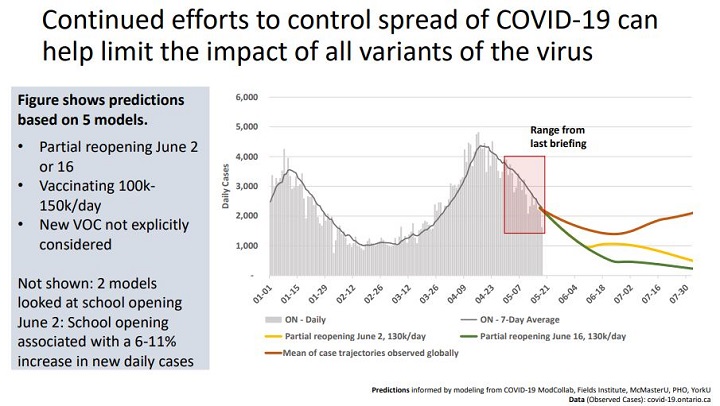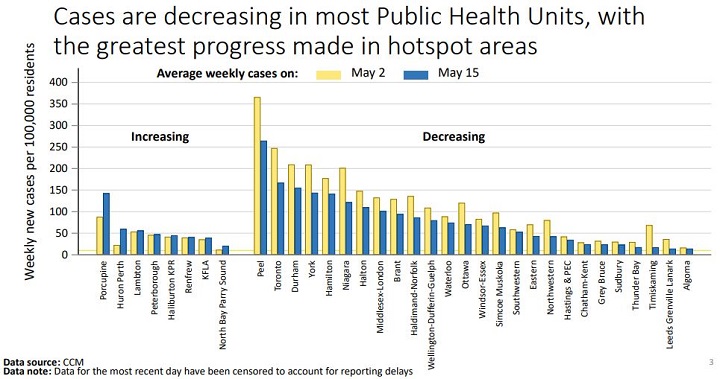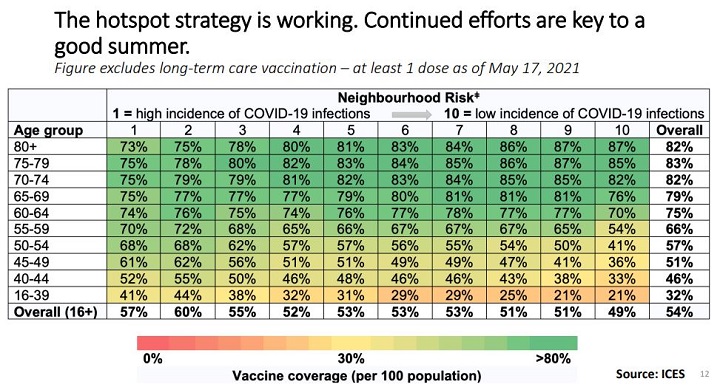Ontario’s latest modelling projections indicate that maintaining good progress on COVID-19 vaccinations and some public health measures until mid-June “can help ensure a good summer.”

On Thursday, the science advisory table released modelling documents that indicated cases, test positivity and hospitalization rates are declining. It also said due to current public health measures “control of the pandemic is improving.”
However, officials also noted that “school reopening will create an increase in cases” but that this “may be manageable.”
They also said outdoor activities are much safer than indoor activities and should be encouraged.
Premier Doug Ford is set to unveil a gradual reopening plan for the province Thursday at 3 p.m. The current stay-at-home order is expected to expire on June 2.
Dr. Adalsteinn (Steini) Brown, co-chair for Ontario’s COVID-19 Science Advisory Table, told reporters Thursday that based on modelling a reopening on June 2 will likely lead to a rise in cases that will likely subside later in the summer.
“Waiting until the middle of June to reopen will likely bring cases down to a very low level and a consistent downward trend throughout the summer,” Brown said.
Brown added that reopening schools on June 2, but nothing else, takes the province “somewhere between these two options.” The documents said school reopening could see a six to 11 per cent increase in new daily cases.
The variants of concern are a “wild card” amid the pandemic, Brown said. He said if a new variant, that is resistant against vaccines, enters Ontario that the province may lose control again.
“But the fewer cases we have, the better we will be able to control new variants as they emerge,” Brown said.

Get weekly health news
Thursday saw 2,400 new COVID-19 infections, which was higher than the previous two days which saw case counts below 2,000. However, in the last month test positivity has dropped from around 10 per cent to five per cent on Thursday.
A month ago, daily case counts were around 4,000 or higher which shows a significant decline — although daily case counts are still higher than they were last spring and summer.
The documents also indicated that cases are decreasing in most public health units with the greatest differences in hot spot areas. Ontario recently shifted its vaccination rollout from age-based vaccinations to targeting everyone in hotspots, sending an influx of vaccines to areas like Toronto, Peel, York and Durham regions.
However, in more rural and northern areas of Ontario (such as Porcupine and Huron Perth health units) there has been an increase in cases.
Hospitalizations have also decreased from around 2,300 admissions one month ago to 1,320 on Thursday. However, officials noted that ICU capacity has only dropped slightly from the high 800s a month ago to 721 on Thursday.
“The direction of the pandemic has turned,” Brown said.
“If we’re careful and cautious, we can maintain this momentum. And this momentum is what gets us to a good summer,” he added.
Higher vaccination coverage has started to control hospitalizations in older age groups, officials noted in the documents. More than 80 per cent of those aged 70 and older have at least one dose of vaccine. Vaccinations with at least one dose in those aged 60 to 64 are at 75 per cent, and 79 per cent for people aged 65 to 69.
So far, Ontario has administered more than 7.5 million vaccine doses, with between 100,000 and 150,000 vaccinations daily. There are 473,759 people fully vaccinated with two doses.
“Our vaccine rollout has been impressive of late … and the public health measures, however taxing and frustrating, have helped stop the spread,” Brown said.
When it comes to outdoor activities, the science table outlined a “two-out-of-three rule.”
If it’s outdoors and with more than two metres of distance then masks are not required. It it’s outdoors but there is less than two metres of distance then masks are required.
Also listed were byproducts to avoid when engaging in outdoor activities:
- dining indoors, dining with others and sharing food or drinks
- crowding and going to crowded places
- carpooling with others
- traveling between regions
- sharing overnight accommodation with others
- locker rooms and shared amenities












Comments